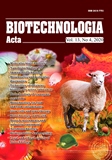ISSN 2410-7751 (Print)
ISSN 2410-776X (Online)

Biotechnologia Acta V. 13, No 4, 2020
Р. 71-80, Bibliography 30, English
Universal Decimal Classification: 579.841: 577.114
https://doi.org/10.15407/biotech13.04.071
Pirog Т. P., Voronenko А. А., Yarosh М. B.
National University of Food Technologies, Kyiv, Ukraine
The aim of the work was to establish the cultivation conditions of Acinetobacter sp. IMV B-7005 for providing the maximum indicators of the exopolysaccharide ethapolan synthesis on the mixture of acetate and sunflower oil, as well as to study the possibility of replacing the refined oil in the mixture with acetate on a waste one.
The optimal molar ratio of concentrations for refined sunflower oil and acetate in the mixture was calculated theoretically according to Babel’s concept of “auxiliary substrate”. The EPS concentration was determined gravimetrically after precipitation with isopropanol. The EPS-synthesizing ability was calculated as the ratio of the EPS concentration to the concentration of biomass and expressed in g EPS/g biomass.
Based on theoretical calculations of energy requirements for EPS synthesis and biomass of Acinetobacter sp. B-7005 on energy-deficient substrate (acetate) it was found that molar ratio for the concentrations of sodium acetate and oil in the mixture, at which the maximum EPS synthesis was achieved, should be 1:0.13. It was experimentally confirmed that at this ratio of monosubstrate concentrations and the use of the inoculum grown on refined oil, the synthesis rates of ethapolan were higher than at the other ratios of acetate and oil concentrations in the mixture. However, the assimilation of sodium acetate through the symport with proton led to an increase in pH of the culture liquid to 9.0–9.3, which is not optimal for EPS synthesis. Decrease of the medium alkaline component and fractional introduction of substrates enabled not only to stabilize pH at the level of 7.8–7.9, but to increase the amount of synthesized ethapolan to 16–17 g/l, which was achieved regardless of the type of used oil (refined or mixed waste) in the mixture with acetate.
Key words: Acinetobacter sp. IMV В-7005, mixed substrates, waste oil, fractional substrate introduction.
© Palladin Institute of Biochemistry of the National Academy of Sciences of Ukraine, 2020
References
1. An С., Ma S., Chang F., Xue W. Efficient production of pullulan by Aureobasidium pullulans grown on mixtures of potato starch hydrolysate and sucrose. Braz. J. Microbiol. 2017, 48 (1), 180?185. https://doi.org/10.1016/j.bjm.2016.11.001
2. Asgher M., Urooj Y., Qamar S. A., Khalid N. Improved exopolysaccharide production from Bacillus licheniformis MS3: optimization and structural/functional characterization. Int. J. Biol. Macromol. 2020, V. 151, P. 984?992. https://doi.org/10.1016/j.ijbiomac.2019.11.094
3. Babel W., M?ller R. H. Mixed substrates utilization in microorganisms: biochemical aspects and energetics. J. Gen. Microbiol. 1985, 131 (1), 39?45. https://doi.org/10.1099/00221287-131-1-39
4. Barcelos M. C. S., Vespermann K. A. C., Pelissari F. M., Molina G. Current status of biotechnological production and applications of microbial exopolysaccharides. Crit. Rev. Food Sci. Nutr. 2020, 60 (9), 1475?1495. https://doi.org/10.1080/10408398.2019.1575791
5. Br?hl L. Fatty acid alterations in oils and fats during heating and frying. Eur. J. Lipid Sci. Technol. 2014, 116 (6), 707?715. https://doi.org/10.1002/ejlt.201300273
6. Hussain A., Zia K. M., Tabasum S., Noreen A., Ali M., Iqbal R., Zuber M. Blends and composites of exopolysaccharides; properties and applications: A review. Int. J. Biol. Macromol. 2017, 94 (Pt. A), 10?27. https://doi.org/10.1016/j.ijbiomac.2016.09.104
7. Maalej H., Hmidet N., Boisset C., Buon L., Heyraud A., Nasri M. Optimization of exopolysaccharide production from Pseudomonas stutzeri AS22 and examination of its metal-binding abilities. J. Appl. Microbiol. 2015, 118 (2), 356?367. https://doi.org/10.1111/jam.12688
8. Pidhorskyy V., Iutinska G., Pirog T. Intensification of microbial synthesis technologies. Кyiv: Nauk. dumka. 2010, 327 p. (In Ukrainian).
9. Pirog T. P., Ivakhniuk M. O., Voronenko A. A. Exopolysaccharides synthesis on industrial waste. Biotechnol. acta. 2016, 9 (2), 7?18. https://doi.org/10.15407/biotech9.02.007
10. Pirog T. P., Ivakhniuk M. O., Voronenko A. A. Microbial synthesis of exopolysaccharide ethapolan on various types of waste vegetable oils. Vestsi Natsyyanal’nai akademii navuk Belarusi. Seryya biyalagichnych navuk. 2017, N 2, P. 87?93. (In Russian).
11. Pirog T. P., Ivanushkina G. O., Garbarchuk S. O. The synthesis of polysaccharide ethapolan depending on Acinetobacter sp. В-7005 cultivation conditions. Scientific Works of NUFT. 2011, N 37?38, P. 42?46. (In Ukrainian).
12. Pirog T. P., Voronenko A. A., Ivakhniuk M. O. Intensification of microbial exopolysaccharide ethapolan biosynthesis on mixture of molasses and sunflower oil. Biotechnol. acta. 2017, 10 (4), 25?33. https://doi.org/10.15407/biotech10.04.025
13. Rahbar Saadat Y., Yari Khosroushahi A., Pourghassem Gargari B. A comprehensive review of anticancer, immunomodulatory and health beneficial effects of the lactic acid bacteria exopolysaccharides. Carbohydr. Polym. 2019, V. 217, P. 79?89. https://doi.org/10.1016/j.carbpol.2019.04.025
14. Ratledge C. Biodegradation of oils, fats and fatty acids. In: Biochemistry of microbial degradation. Dordrecht: Kluwer Academic Publishers. 1994, 590 p. https://doi.org/10.1007/978-94-011-1687-9_4
15. Rishi V., Sandhu A. K., Kaur A., Kaur J., Sharma S., Soni S. K. Utilization of kitchen waste for production of pullulan to develop biodegradable plastic. Appl. Microbiol. Biotechnol. 2020, 104 (3), 1307?1317. https://doi.org/10.1007/s00253-019-10167-9
16. R?hmann B., Schmid J., Sieber V. Methods to identify the unexplored diversity of microbial exopolysaccharides. Front. Microbiol. 2015, 6 (565), 1?8. https://doi.org/10.3389/fmicb.2015.00565
17. Sengupta D., Datta S., Biswas D. Exploring two contrasting surface-active exopolysaccharides from a single strain of Ochrobactrum utilizing different hydrocarbon substrates. J. Basic. Microbiol. 2019, 59 (8), 820?833.https://doi.org/10.1002/jobm.201900080
18. Singh R. S., Kaur N., Kennedy J. F. Pullulan production from agro-industrial waste and its applications in food industry: A review. Carbohydr. Polym. 2019, V. 217, P. 46?57. https://doi.org/10.1016/j.carbpol.2019.04.050
19. Voronenko A. A., Ivakhniuk M. O., Pirog T. P. Exopolysaccharide ethapolan synthesison molasses and sunflower oil mixture depending on the method of molasses preparation. Scientific Works of NUFT. 2019, 25 (3), 42?48. (In Ukrainian). https://doi.org/10.24263/2225-2924-2019-25-3-7
20. Zhang Q., Saleh A. S., Chen J., Shen Q. Chemical alterations taken place during deep-fat frying based on certain reaction products: a review. Chem. Phys. Lipids. 2012, 165 (6), 662?681. https://doi.org/10.1016/j.chemphyslip.2012.07.002

